 ENCYCLOPEDIA OF ELLIS ISLAND
ENCYCLOPEDIA OF ELLIS ISLAND ENCYCLOPEDIAOF ELLIS ISLANDBarry MorenoGREENWOOD PRESS Westport, Connecticut London
ENCYCLOPEDIAOF ELLIS ISLANDBarry MorenoGREENWOOD PRESS Westport, Connecticut London  Library of Congress Cataloging-in-Publication Data Moreno, Barry. Encyclopedia of Ellis Island / Barry Moreno. p. cm. Includes bibliographical references (p.) and index. paper) 1. paper) 1.
Library of Congress Cataloging-in-Publication Data Moreno, Barry. Encyclopedia of Ellis Island / Barry Moreno. p. cm. Includes bibliographical references (p.) and index. paper) 1. paper) 1.
Ellis Island Immigration Station (N.Y. and N.J.)Encyclopedias. 2. United StatesEmigration and immigrationHistoryEncyclopedias. I. Title.
JV6484.M67 2004 304.873dc22 2004054380 British Library Cataloguing in Publication Data is available. Copyright 2004 by Barry Moreno All rights reserved. No portion of this book may be reproduced, by any process or technique, without the express written consent of the publisher. Library of Congress Catalog Card Number: 2004054380 ISBN: 0313326827 First published in 2004 Greenwood Press, 88 Post Road West, Westport, CT 06881 An imprint of Greenwood Publishing Group, Inc. www.greenwood.com Printed in the United States of America The paper used in this book complies with the Permanent Paper Standard issued by the National Information Standards Organization (Z39.481984). 10 9 8 7 6 5 4 3 2 1 To my young nephews, Sergio and Victor Moreno ContentsAcknowledgmentsixIntroductionxiChronologyxxiAlphabetical List of EntriesxxviiList of Entries by SubjectxxxiiiList of Entries of Persons by Field of Endeavor or BackgroundxliEncyclopediaAppendix 1Ellis Island: Its Organization and Some of Its WorkAppendix 2Personnel Report of 1909Appendix 3Rules for the U.S.
Immigrant Station at Ellis IslandBibliographyIndexAcknowledgments The first person to whom I must give thanks is Virginia Yans-McLaughlin, who when approached to write this book, declined and recommended me as the best person to undertake it. Since I had previously filled a notebook with plans for such a book, I was truly delighted when Wendi Schnaufer of Greenwood Press telephoned me on Professor Yans-McLaughlins recommendation and asked if I would be interested in writing the book. Throughout my years at Ellis Island, I have had stimulating conversations and worked on numerous projects with many people, including a great variety of co-workers, authors, researchers, and specialists. I thank them all, especially museum staff members Diana R. Pardue, Jeffrey S. Dosik, Eric Byron, Janet Levine, Kevin Daley, George D.
Tselos, Ken Glasgow, Sydney Onikul, Judith Giuriceo, Richard D. Holmes, Nora Mulrooney, Geraldine Santoro, Doug Tarr, Wiley Steve Thornton, Patricia Hom, Paul Roper, and Stephen Keene. Also former Ellis Island staff members Brian Feeney, Frank DePalo, Marcy Cohen David-son, Paul Sigrist, Carl Rutberg, Robert Cecchi, Paul Kinney, Peter Stolz, George Hennes-sey, Steven Czarniecki, Felice Ciccione, and many others. Also helpful were Superintendent Cynthia Garrett, Deputy Superintendents Frank Mills and David Luchsinger, horticulturist Alfred Farrugio, concessions specialist Michael Conklin, and architect Don Fiorino, Deborah Falik, and our museum volunteers, including David H. Cassells, Charles B. Lemonick, North Peterson, Mary Fleming, John Kiyasu, Javier, Agramonte, and Joachim Baur.
The Statue of LibertyEllis Island Foundation has also been helpful, especially Peg Zitko, and Stephen A. Briganti and, at the American Family Immigration History Center, I must thank Catherine Daley and David Diakow, for their unfailing support. Scholars, experts, and researchers have also been helpful indeed. These include historians Marian L. Smith, John Parascandola, Fitzhugh Mullan, Peter Mesenhoeller, Roger Daniels, and Robert Stein; archivists Brian G. Andersson, John Celardo, and the late Robert Morris; publisher and writer Loretto Dennis Szucs; Ellis Island immigrants Isabel Belarsky and Emmie Kremer; authors Tom Bernardin and Dennis Wepman; and documentary filmmaker Lorie Conway.
I thank my wonderful editor, Wendi Schnaufer, at Greenwood Press, project editor, Judy Thurlow, at Capital City Press, and all those who have contributed to the development and production of this book. Introduction Ellis Island, located at the southern tip of Manhattan in New York Bay, is renowned as the major immigrant portal to the United States. Its historical importance cannot be overstated. Along with the Statue of Liberty, with which it now shares national monument status, Ellis Island is the most significant symbol of the opportunities that awaited immigrants arriving on U.S. shores. history. history.
Approximately 12 million immigrants, mostly Europeans, were processed on the island from 1892 through 1954. Their cultural contributions are celebrated as part of the American Dream. Their children and grandchildren became part of the American middle class. Today, perhaps 25 percent of Americans have an ancestor who was processed at Ellis Island. After extensive restoration, Ellis Island has a new purpose: it is the premier historical museum for immigration and genealogical research in this country and is a major tourist attraction and student group destination in New York. Many reference books have been written about immigration in general, but this encyclopedia is the first reference book devoted to the subject of Ellis Island.
General topics in this volume include children, languages and dialects, literature, wars, and women, along with specific laws, policies and procedures, notables and staff, organizations, buildings and rooms, and the various in-carnations of its use until the founding of the current museum. The need for this volume was dictated by the lack of well-organized and easily accessible publications that simplify the search for general knowledge of the islands history. The purpose of this encyclopedia is to remedy that situation. Nonetheless, this volume is limited in its coverage simply because of the vastness of the story. The basic history is covered here with the emphasis on Ellis Island as an immigrant station from 1892 through 1954. The criterion for entry selection was overall significance to the history of the island.
Thus, for example, federal agencies, commissioners, various people, divisions, and diseases were all determined as vital to readers and researchers. Whenever possible, the entries have been named as they were known at Ellis Island. Hence, the entry on immigration inspectors is called immigrant inspectors because that was the term used on Ellis Island. The following brief, historical overview of the island will help put the contents of this encyclopedia in perspective. THE EARLY HISTORY OF ELLIS ISLAND (16201890) When the Dutch arrived, Ellis Island formed part of the domain of the Lenni Lenape Indians, who fished and gathered oysters from its shores. They called the sandbar KioshkGull Island for it was inhabited by many of these seafaring birds.
In the 1630s, Michael Paauw purchased the dreary isle from the tribe for certain cargoes or parcels of goods. During these early years, the Dutch found the oyster beds rich and profitable, xiiIntroduction and the island came to be known as Little Oyster Island. The three-and-a-half-acre sandbar, however, attracted no settlers. In 1674, shortly after English colonial rule was made permanent by the Treaty of Westminster (ending the Third Anglo-Dutch War), the English governor, Sir Edmund Andros, granted Little Oyster Island to Captain William Dyre. In 1686, Dyre and his wife Mary sold the island to Thomas and Patience Lloyd. After Lloyds death about a decade later, the isle passed into other hands.
Next page
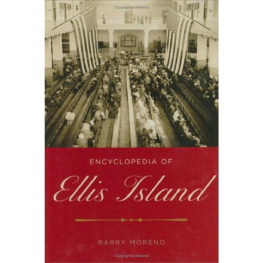
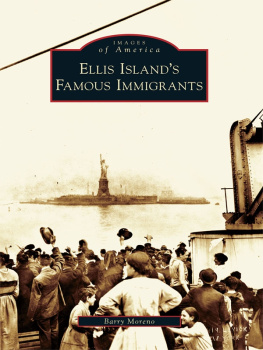
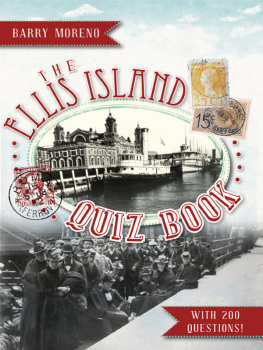



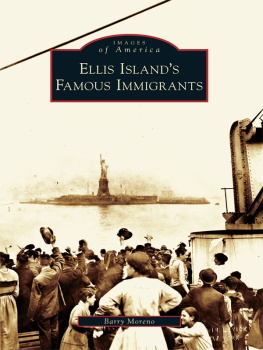

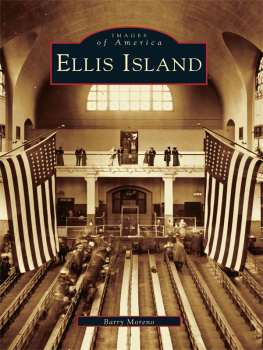
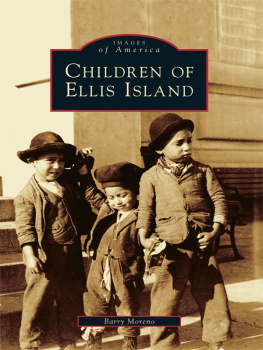
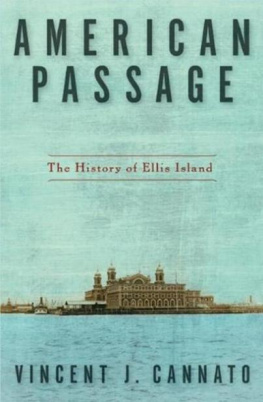
 ENCYCLOPEDIA OF ELLIS ISLAND
ENCYCLOPEDIA OF ELLIS ISLAND ENCYCLOPEDIAOF ELLIS ISLANDBarry MorenoGREENWOOD PRESS Westport, Connecticut London
ENCYCLOPEDIAOF ELLIS ISLANDBarry MorenoGREENWOOD PRESS Westport, Connecticut London  Library of Congress Cataloging-in-Publication Data Moreno, Barry. Encyclopedia of Ellis Island / Barry Moreno. p. cm. Includes bibliographical references (p.) and index. paper) 1. paper) 1.
Library of Congress Cataloging-in-Publication Data Moreno, Barry. Encyclopedia of Ellis Island / Barry Moreno. p. cm. Includes bibliographical references (p.) and index. paper) 1. paper) 1.